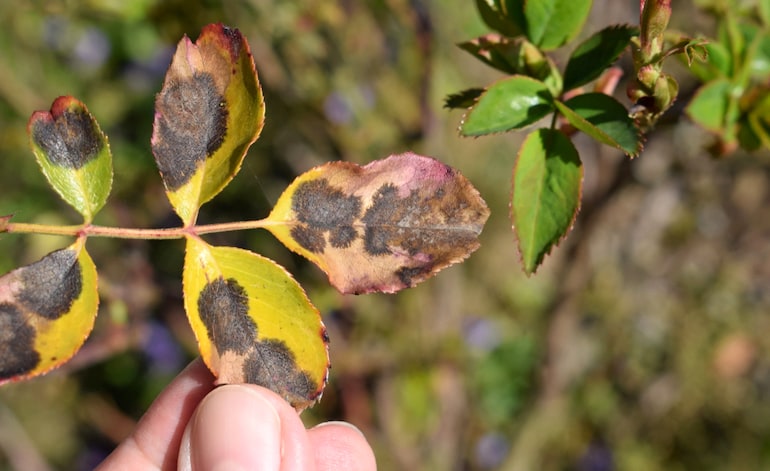Garden diseases - Leaf spot

Black spots are a sign of plant fungal infections
Image: matunka/Shutterstock
Disfiguring black spots are almost certainly a sign of one of several fungal infections which can damage and kill some plants. If your flowers and plants are developing dark spots on the leaves, here's what to do about it.
What is leaf spot?

Keep your eye out for leaf spots on your plants
Image: TMsara/Shutterstock
An array of fungi can infect ornamental plants, flowers and vegetables causing unsightly spots to develop on the leaves. Some infections, like Peronospora violae, are specific to certain plants like pansies and violas - rotting the crown, killing the plant and spreading the fungus to others nearby. Other infections, like Mycocentrospora acerina, attack the leaves and roots of a wide range of ornamental plants and vegetables.
How to treat leaf spot

Binning infected plants can be one way of stopping the spread of leaf spot
Image: Shutterstock
Though there are several causes of leaf spot, the treatment is the same for all of the infections mentioned above.
- Chemical treatment. If you spot a fungal infection, immediately remove the affected leaves and dispose of them with your household waste before treating the remaining plants with a suitable systemic fungicide.
- Non-chemical treatments. Treating black spot is simple and easy to do provided you act promptly by taking the following steps:
- Remove contaminated material - strip off affected leaves or remove whole plants and dispose of them by burning or putting them out with your household waste. Avoid composting diseased material because the conditions in your compost heap are ideal for the incubation of next year's fungal infection.
- Collect and dispose of any infected leaves littering the ground.
- Sterilise any plant containers and tools before using them again.
How to prevent leaf spot

Keep your greenhouse well ventilated to minimise the risk of fungal leaf spot
Image: Linda GeorgeE/Shutterstock
Fungal infections which cause leaf spot on pansies and other plants sometimes come from infected wild or cultivated plants growing in the vicinity. The infection spreads either on the wind or through splashes of water infected with spores. If you've had a problem with pansy leaf spot, try not to grow pansies in the same place for at least a year because the earth they grew in may well harbour spores.
When growing plants like chilli in the greenhouse or indoors, avoid overwatering. Fungus thrives in moist conditions, especially if there's inadequate ventilation. Make sure you open your greenhouse door and windows to allow the air to circulate, and always water the roots rather than leaves.
In most cases, you can easily prevent fungal infections by growing your plants in optimum conditions. Strong and healthy plants are less likely to succumb. Camellia leaf spot is often caused by overwatering or nutrient imbalances, but if it's only affecting a few leaves, simply pick them off and destroy them. Check that your camellias are planted in moist, well-drained, acidic soil, in a sheltered, shady spot.
Leaf spot is a common problem but luckily it's usually easy to contain if you're vigilant, act promptly to get rid of diseased material, and avoid replanting the same plants in the same spot.
Other pages you might like
See all pests & diseases guides
Individual guides
Diseases
- Apple scab
- Bacterial canker
- Blackleg
- Blossom wilt
- Botrytis
- Brown rot
- Clematis wilt
- Downy mildew
- Fungal disease
- Honey fungus
- Leaf scorch
- Leek rust
- Lily disease
- Peach leaf curl
- Pear rust
- Phytophthora root rot
- Potato & tomato blight
- Powdery mildew
- Silver leaf fungus
- Tomato greenback
- Tomato leaf curl
- Tomato stem canker







